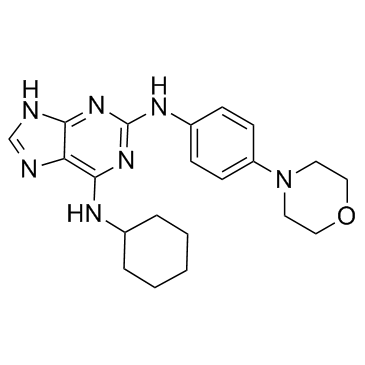656820-32-5
| Name | reversine |
|---|---|
| Synonyms |
N-cyclohexyl-N-[4-(morpholin-4-yl)phenyl]-1H-purine-2,6-diamine
2vgo 1H-purine-2,6-diamine, N-cyclohexyl-N-[4-(4-morpholinyl)phenyl]- 2-(4-morpholinoanilino)-6-cyclohexylaminopurine 6-N-cyclohexyl-2-N-(4-morpholin-4-ylphenyl)-7H-purine-2,6-diamine Reversine 9H-Purine-2,6-diamine, N-cyclohexyl-N-[4-(4-morpholinyl)phenyl]- N-Cyclohexyl-N-[4-(4-morpholinyl)phenyl]-3H-purine-2,6-diamine |
| Description | Reversine is a novel class of ATP-competitive Aurora kinase inhibitor with IC50s of 400, 500 and 400 nM for Aurora A, Aurora B and Aurora C, respectively. |
|---|---|
| Related Catalog | |
| Target |
Aurora A:400 nM (IC50) Aurora B:500 nM (IC50) Aurora C:400 nM (IC50) |
| In Vitro | Reversine, a novel Aurora kinases inhibitor, inhibits colony formation of human acute myeloid leukemia cells. Reversine is a potent inhibitor of Aurora A and B and is also an inhibitor of Aurora C kinase. Aurora A and B activities are inhibited by 80% and Aurora kinase C by 55%, already at a concentration of 0.5 μM, whereas no inhibition or only modest inhibition is observed on others kinases tested. In a second round of experiments, the IC50 of Reversine is determined on Aurora kinase A to be 400 nM, whereas Aurora kinase B and C IC50 are 500 and 400 nM, respectively. The IC50 is also determined on MEK1 is >1.5 μM and that the IC50 on muscle myosin (an analogue of nonmuscle myosin II) is 350 nM[1]. |
| In Vivo | The combination of Reversine and aspirin can more efficiently induce cell cycle arrest and apoptosis. To evaluate the anti-tumor effect of this combination, a xenograft nude mouse model is established by s.c. injection. Mice inoculated with cervical cancer cells have lost about 10 % of their initial body weight by about 16 days after tumor inoculation. However, tumor growth (tumor weight) is reduced and the mice survive longer in the combination group[2]. |
| Cell Assay | HCT116 and HL60 cells are incubated with either 5 μmol/L Reversine or DMSO 0.01%. Cells are harvested and fixed in 70% ethanol overnight. After double washing with PBS, cells are labeled with cell cycle staining reagent PBS, 0.1% Triton X-100, 200 μg/mL DNase-free RNase, and 25 μg/mL propidium iodide and incubated at room temperature in the dark for 30 min. DNA content is analyzed using FACSCalibur. Cell viability of different tumor cell lines is assessed using ATPlite 1step. Briefly, 2×104 cells for each well are plated in a 96-well plate in presence of crescent quantity of Reversine. After 72 h, the plates are recovered and 100 μL ATPlite solution is added to each well. The plates are shaken for 2 min at 700 rpm and luminescence is measured using EnVision Multilabel plate reader. Each sample is analyzed in triplicate[1]. |
| Animal Admin | Mice[2] Female athymic 6-8 weeks old BALB/c nude mice are used. U14 cell suspension (5×106 cells in 100 μL of RPMI-1640 medium) is injected subcutaneously. The purpose of developing cervical tumors is to generate histological intact tumors for drug therapy. When the diameter of tumors reached up to about 1 cm, Reversine, aspirin or their combinations are administrated by intraperitoneal injection per 3 days, twenty-five of these mice are randomly assigned into one of the following five groups: (a) mice treated with RPMI-1640 medium, (b) mice treated with DMSO, (c) mice treated with Reversine (10 mg/kg), (d) mice treated with aspirin (1 μg/kg) and (e) mice treated with a Reversine and aspirin combination. Body weight and tumor size at the site of inoculation are measured three times a week. Tumor size is measured every 3 days from two diameters, tumor volume is estimated using the formula L×S2/2(L as the longest diameter, S as the shortest diameter). |
| References |
| Density | 1.343±0.06 g/cm3 |
|---|---|
| Boiling Point | 736.4±70.0 °C at 760 mmHg |
| Melting Point | 305 ºC (decomp) |
| Molecular Formula | C21H27N7O |
| Molecular Weight | 393.485 |
| Flash Point | 399.2±35.7 °C |
| Exact Mass | 393.227722 |
| PSA | 90.99000 |
| LogP | 1.23 |
| Appearance | solid |
| Vapour Pressure | 0.0±2.4 mmHg at 25°C |
| Index of Refraction | 1.712 |
| Storage condition | 2-8°C |
| Water Solubility | Insuluble (3.7E-4 g/L) (25 ºC) |
| Symbol |

GHS07 |
|---|---|
| Signal Word | Warning |
| Hazard Statements | H302 |
| Personal Protective Equipment | dust mask type N95 (US);Eyeshields;Gloves |
| Hazard Codes | Xn |
| Risk Phrases | 22 |
| RIDADR | NONH for all modes of transport |
| WGK Germany | 3 |
